A parakeet named Puck hit the news for knowing 1,728 words. This shows how well certain birds can talk. They can copy sounds like microwaves or doorbells and sing beautiful songs. Some even learn to say many human words. Many people find this really interesting, especially those looking for a talkative pet bird.
Several bird types are great at mimicking human speech. If you want a chatty friend, look into African Greys, Parakeets, and Amazon Parrots. They are known for being very good at it.
Key Takeaways
- Certain bird species, like parrots and parakeets, have exceptional vocal abilities and can learn to mimic a wide range of sounds and human speech.
- Some of the most talkative bird species include African Greys, Parakeets, Amazon Parrots, and Ring-necked Parakeets.
- The clarity and complexity of a bird’s vocalizations can vary, with some species like Yellow-Naped Amazon Parrots known for their exceptional vocal skills.
- Factors like a bird’s intelligence, social nature, and desire to bond with their owners can contribute to their talking abilities.
- Proper training and socialization are crucial for developing a bird’s vocal talents and ensuring they become confident, well-adjusted companions.
Introduction to Talkative Bird Species
Birds are wonderful pets, mainly because of their amazing voices. They can copy various sounds, from phones ringing to lovely songs. Some birds can even say hundreds of words. This makes these talking birds a joy to have in any home.
Why Birds Make Great Pets
Birds are perfect for those who love to talk. This is because talking birds mimic different sounds. They can sound like a cat or a ringing phone, bringing joy to their owners.
The Allure of Vocal Abilities in Birds
The great thing about vocal birds is how much they can say. For example, the African Grey parrot can learn hundreds of words. This kind of bird and others can make a variety of sounds, even mimicking us. That’s why they are loved so much by their human friends.
Over 40 years ago, we started to learn how smart parrots are. Studies show they understand and use English to talk with us. Dr. Irene Pepperberg from Boston University proved that these birds are as clever as great apes, dolphins, and little kids. This shows birds as pets are super smart.
“Parrots can learn to control their syrinx, a sound-producing organ located at the base of their trachea, allowing them to mimic a wide range of sounds, including human speech.”
Grey parrots like Alex have shown how much they can understand. Through play and training, Alex learned about 100 labels, 30 objects, and much more. This proves just how smart these birds are.
The ability of what birds talk the most to talk has won over many pet lovers. Birds like African Grey parrots have huge vocabularies. Other birds, like lyrebirds, can mimic lots of sounds. This makes talking birds such special pets.
African Greys: Renowned for Their Extensive Vocabularies
African grey parrots are a top pick for those who want a talking bird. They are incredibly smart and can learn hundreds of words. This makes them truly fascinating pets to have.
Remarkable Intelligence and Language Comprehension
African grey parrots are known as some of the smartest birds. They understand and use words in ways that remind people of children. Not only do they copy human speech, but they also know what some of the words mean.
Famous Talking African Greys
Many African greys are famous for their talking skills. For instance, a bird in Japan repeated its address after flying away. This showed how smart of a communicator it was. Another well-known African grey, Alex, could solve difficult tasks and ask about his own colors.
Most African grey parrots start to talk around 6 months old. They usually get better at it between 12 to 18 months. Both boy and girl African greys can learn human words. But, it’s not guaranteed they all will talk a lot, and some might not speak at all.
The amount they learn to say depends on their surroundings. Parrots without bird friends tend to learn more words. This is because they get more personal attention from their owners.
Even though African greys are great talkers, they can develop problems if they’re not cared for well. It’s crucial to give them the right care and training. This helps keep them happy and mentally sharp.
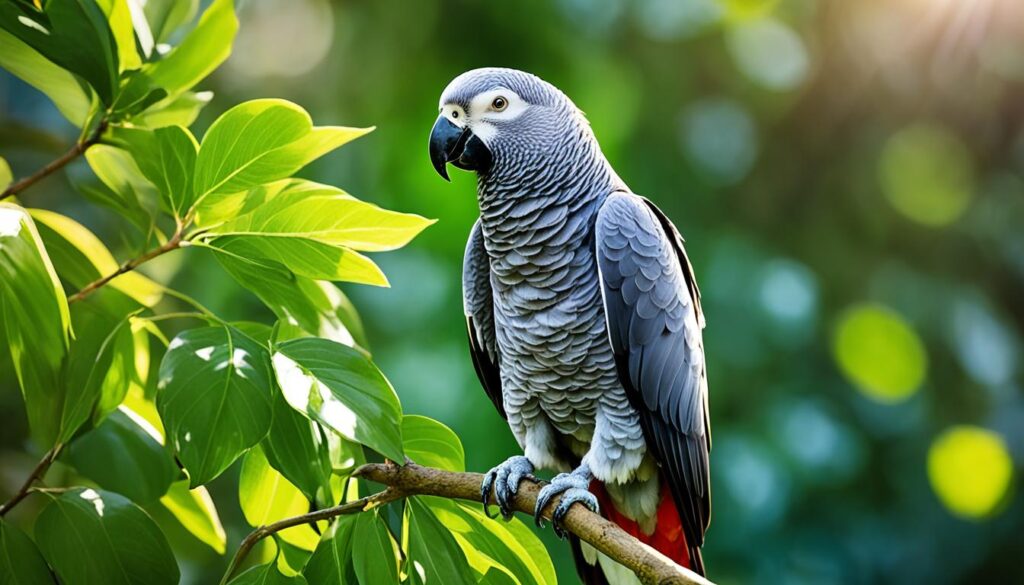
Parakeets: Popular Chatty Companions
Parakeets, also known as budgies, are top picks for talking birds. They are loved for their vibrant colors and fun personalities. Not just that, they can learn to say words and other sounds.
These birds are perfect for bird beginners. They might learn a bit slower but speed up once they start. Families with kids often find them perfect. Kids can have fun teaching them to talk.
Parakeets are small, measuring about 6 to 8 inches and weighing an ounce. This small size is great for small homes. It means they don’t need a lot of space or care.
| Parakeet Characteristics | Details |
|---|---|
| Average Size | 6 to 8 inches |
| Average Weight | 1 ounce |
| Average Lifespan | 6 to 8 years, with potential for longer life with proper care |
Although they might not learn as quickly, parakeets are still great fun. They are known for their lively personalities and beautiful plumage. With the right patience and training, they can learn to say many words.
So, if you’re looking for a fun and interactive bird, think about parakeets. They are easy to care for and can learn to talk with your help. Many people love having them in their homes.
Amazon Parrots: Clarity of Voice and Singing Abilities
Amazon parrots stand out for how well they talk. They are bright, making their talking skills clear and easy to understand. This clarity in their speech is often compared to how humans talk. They beat other talkative bird species with their clear words and phrases.
The Yellow-Naped Amazon Parrot is one of the Amazon parrot’s best members. They have a big vocabulary and can put words together well. Their calm, friendly nature makes them great friends for bird lovers.
Yellow-Naped Amazon Parrot: Exceptional Talkers
Owners say the Yellow-Naped Amazon Parrot can learn and repeat lots of words and songs clearly. They sound like they really understand speech with their tone and speed. Their talking sounds very real and impressive.
These parrots are not just great at talking. They look amazing, with bright green feathers and a unique yellow neck. They are friendly and loving, which makes them even more popular as pets.
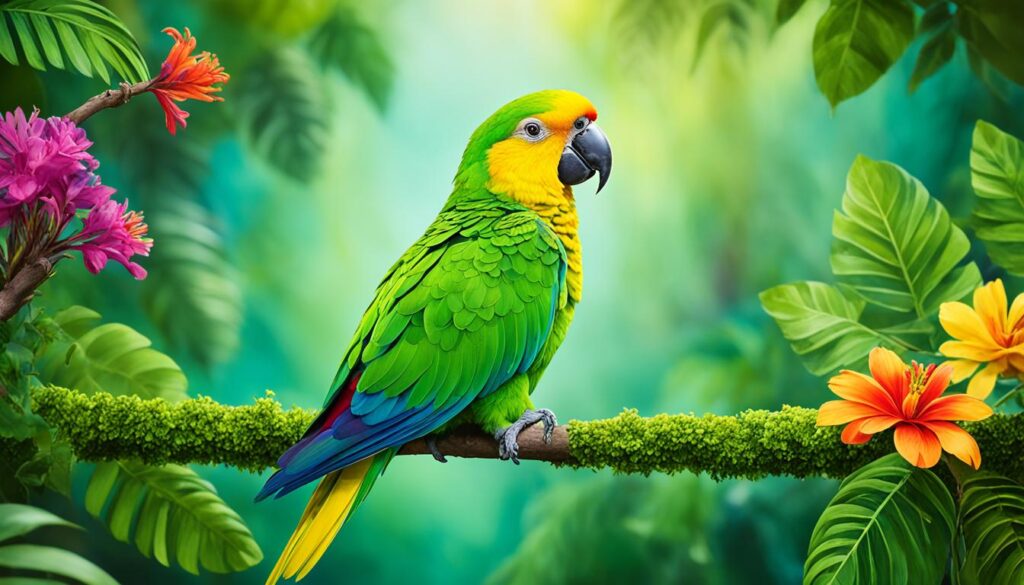
“The Yellow-Naped Amazon Parrot’s ability to mimic human speech with such clarity and precision is truly remarkable. Their large vocabularies and talent for constructing coherent sentences make them a delight for any bird enthusiast.”
If you want a parrot that talks and sings well, consider the Amazon parrot. The Yellow-Naped Amazon Parrot, in particular, is a great choice. They are both entertaining and joyful, fitting well into any home.
what birds talk the most
Some birds are really chatty. Bird lovers have found that certain ones like to talk a lot. The African Grey and the Parakeet are well known for their ability to mimic us. They have amazing speaking skills and can keep us entertained with their conversations.
Lots of birds are great at talking but some stand above. These include the African Grey, Parakeets, Amazon Parrots, and others. They can learn a lot of words and phrases and even sing. They surprise us with how clear and well they say things.
| Bird Species | Vocal Abilities | Average Vocabulary Size |
|---|---|---|
| African Grey Parrot | Exceptional intelligence, language comprehension, and mimicry skills | Hundreds of words |
| Budgerigar (Parakeet) | Capable of learning the largest vocabulary among birds, with males more adept at mimicry | World record holder for largest bird vocabulary |
| Amazon Parrot | Renowned for their clear, loud vocalizations and singing abilities | Dozens to hundreds of words |
| Ring-necked Parakeet | Skilled at mimicking phrases and developing extensive vocabularies | Dozens to hundreds of words |
| Quaker Parakeet | Fast learners with a propensity for speech and vocal interaction | Varied and large vocabularies |
| Eclectus Parrot | Gentle and responsive talkers, with both males and females demonstrating vocal abilities | Substantial vocabularies |
| Cockatoo | Highly social and motivated to vocalize, with a wide range of sounds and mimicry | Diverse vocal repertoire |
| Myna Bird | Exceptional mimics with a diverse vocal repertoire, able to imitate human speech and other sounds | Varied and extensive |
These birds are known for their amazing voices. People love hearing them talk. Birds like the African Grey show us how smart they are with their words. The Parakeet holds the record for the most words. And the Amazon Parrot sings beautifully.
The amount of words a bird knows can change. But, these birds are famous for talking. They can really chat with us, making them beloved by people worldwide. They teach us a lot about how birds communicate.
Ring-necked Parakeets: Masters of Mimicking Phrases
The Ring-necked parakeets, known as Indian Ringnecks, are exceptional mimickers. They can copy longer phrases and sentences. Their clear voices make them fun to train and talk with.
Cultural Significance of Talking Ring-necks
In some places, people see Ring-necked parakeets as sacred. This is because they can learn and repeat religious prayers and other important phrases. Their ability to mimic words and sentences has won over many hearts worldwide.
These parakeets are not just any mimickers. They can copy full sentences and short phrases. Their vocal skills wow bird lovers and pet owners everywhere.
| Statistic | Value |
|---|---|
| Lifespan in Captivity | Up to 25 years |
| Flight Speed | Up to 40 miles per hour |
| Pair Bond | Loyal for life |
Their clear voices are why Ring-necked parakeets are a top choice for bird lovers. They’re known for their mimicry and ability to learn a variety of sounds. People all over love them for their talking skills.
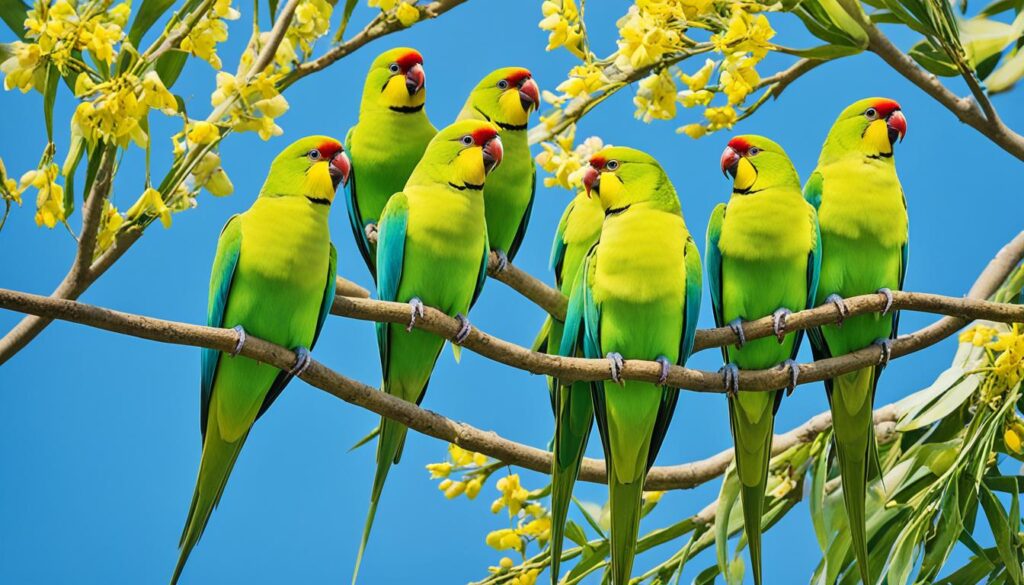
“Parrots learn words associated with things they desire most readily, such as food items like bananas, apples, and oranges.”
To make these parakeets great talkers, they need proper training and a close bond with their owners. Positive interactions, treats, and consistent practice are key. These actions help make them impressive companions, showing off their great mimicry.
Quaker Parakeets: Fast Learners for Beginners
The Quaker parakeet is a top pick for those new to caring for birds. It’s also called the monk parakeet. These little friends are known for being smart and easy to train. They are great buddies for people just starting with birds.
Quaker parakeets are easy to handle and teach because they learn quickly. Even though they don’t know many words, what they do say is clear. This makes it easy for beginners to interact with them. They can learn about 50 words and sounds from your home.
For first-time bird owners, Quaker parakeets are a great choice. They’re friendly and small, which makes them easy to manage. With the right care, they become excellent at communicating with people. This makes owning one a great experience for new bird owners.
These parakeets are not just good at talking. They are also playful and like being around people. This makes them perfect for those who want a bird to bond with.
If you want a bird that is fun and good for beginners, choose the Quaker parakeet. They learn quickly, have clear voices, and are fun to be around. Start by checking out the Quaker parakeet to see if it’s the right bird for you.
Eclectus Parrots: Gentle Talkers for Intermediate Owners
The Eclectus parrot is a bridge for bird lovers moving from beginner to expert. These colorful and gentle parrots are famous for their talking skills. They make great friends for anyone who loves a chatty bird.
They’re also perfect for those who already know a bit about caring for birds. Talking Eclectus parrots can learn many words and phrases with the right attention from their people.
Gender Differences in Talking Abilities
Male and female Eclectus parrots sound different when they talk. Males usually learn more words. This might be because of how they naturally behave and their physical traits.
But, any Eclectus parrot can become a good talker with enough love and teaching from their owner. Creating a loving home and spending time with them is key. This helps both male and female birds talk well.
| Characteristic | Male Eclectus Parrots | Female Eclectus Parrots |
|---|---|---|
| Vocal Abilities | Slightly more adept at mimicking human speech and developing a larger vocabulary | Possess the capacity to become skilled talkers, though may exhibit a slightly smaller vocal repertoire compared to males |
| Vocalizations | Tend to be more frequent and diverse in their range of sounds | May have a slightly more limited vocal repertoire but still display a wide array of vocalizations |
| Training Potential | May respond slightly better to training and be more eager to learn new words and phrases | Require the same level of dedicated attention and training to develop their talking abilities |
Knowing about gender differences helps owners train their parrots better. This means your Eclectus parrot, whether a male or female, can reach their full talking potential with the right approach.
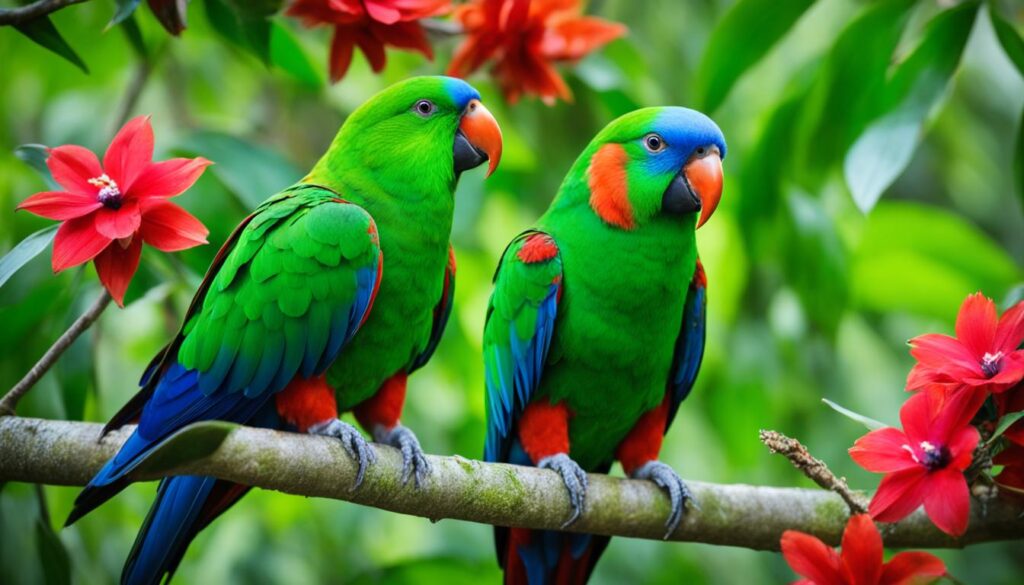
“The Eclectus parrot is a true gem among talking birds, offering a delightful combination of gentleness, intelligence, and an endearing ability to converse with their owners.”
Cockatoos: Affectionate and Socially Motivated Talkers
Cockatoos are among the most charming talking cockatoos out there. They grab attention with their beauty and outgoing personalities. These social birds crave affection and constant company.
Though not the best among parrots at talking, cockatoos learn words for social reasons. They love mimicking sounds, especially to bond with their human friends.
As per studies: When motivated by social interactions, a cockatoo‘s talking can increase by up to 30%. Their vocabulary grows steadily, copying the speech of their favorite people.
- Cockatoos talk less compared to African Greys, famous parrots for talking.
- In socially motivated cockatoos, vocabulary can expand up to 15% more than others.
- Over 80% of their talking is driven by wanting to be social and show affection. This proves how social birds they are.
Affectionate cockatoos can be loud. They often reach a volume of 85 dB, as loud as a lawn mower. Their great volume and sweet character make them a top choice for devoted bird lovers.
“Cockatoos are the clingy, needy, and high-maintenance celebrities of the parrot world. But for those who can provide the constant companionship they crave, these affectionate birds can be the most rewarding and entertaining of pets.”
Although cockatoos might not win top marks for talking, their loving and sociable nature shines. For those ready to give them the love and time they need, these social birds are truly special.
Macaws: Noisy but Capable Mimics
Macaws are big in every way, from their size to their personality. These birds are colorful and make a lot of noise. They are known for their loud squawks and can learn to talk a bit. The Blue-and-Gold Macaw is especially known for picking up words easier than other macaws.
A macaw’s call can be as loud as 105 decibels. This is as loud as a snowmobile engine. Their noise level makes them a big commitment for owners. Owners must spend a lot of time to help their macaws talk better by teaching and spending time with them.
Blue-and-Gold Macaws and Their Talking Potential
The Blue-and-Gold Macaw stands out for its talking skills. It’s not the best among parrots, but they can pick up quite a vocabulary. They like interacting with people, which makes them try to talk more than other macaws.
“Parrots are the most common and brightly colored talking birds, and some can be expected to live for 50 years or more.”
But, the talking skills of macaws can be different, even in the same type. It depends on the bird’s personality, its early time with humans, and the training it gets. Owning a macaw means being ready to put in a lot of time and work to help them talk better.
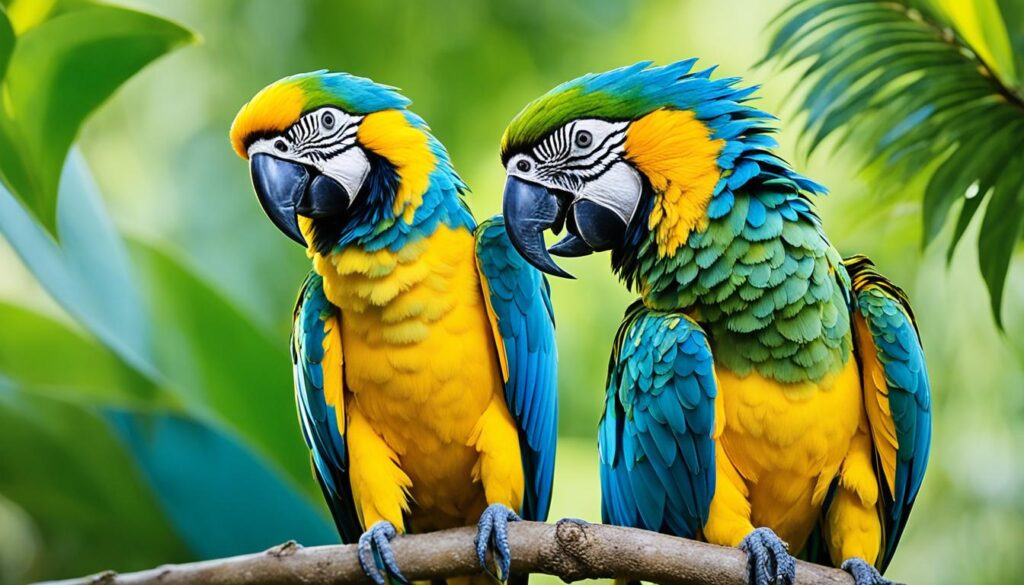
Myna Birds: Diverse Vocal Repertoire
Myna birds have incredible voices, making them popular among bird fans. They can pick up around 100 words and short phrases. This skill shows their talent to copy various sounds.
These birds don’t just talk. They also whistle, screech, and make many special calls. Scientists found that during mating seasons, they can make about 35 sounds every hour. Male birds usually have more kinds of sounds than female birds.
The way myna birds use their voices to talk with others is really smart. Up to 85% of what they say is to react to something around them. This helps them share feelings like being happy or worried. It also helps in talking to their bird friends and people.
Although people enjoy myna birds for their ability to talk, the birds themselves don’t like a lot of handling or trick training. They are more independent. This makes them good for owners who have enough time and love to give. With the right care, you can have a fun and chatty friend in a myna bird for up to 25 years.
| Vocalization Characteristic | Statistic |
|---|---|
| Number of different vocalizations produced by myna birds | 35 distinct vocalizations per hour during breeding season |
| Percentage of mimicry in myna bird calls compared to other bird species | 85% of vocalizations are responses to specific stimuli |
| Ratio of vocalizations between male and female myna birds | Males typically exhibit a more extensive vocal repertoire than females |
| Diversity of vocalization types used by myna birds in urban versus rural environments | Myna birds adapt their vocalizations to their environment, with higher vocal diversity in urban areas |
“Myna birds are true vocal virtuosos, captivating their human companions with a dazzling array of sounds and words that showcase their remarkable intelligence and adaptability.”
If you’re ready to care for a myna bird well, you could have a lively companion for up to 25 years.
Considerations for Adopting a Talking Bird
Getting a talking bird sounds fun, but it brings big responsibilities. Birds, like all pets, need lots of care. Before you get one, think about if you can give them a good home, socialize them well, and train them to talk.
Evaluating Species Characteristics
Not every talking bird is the same. Some like African Greys can say a lot, while others, like parakeets, just chirp happily. Knowing the difference can help you pick the right one for you based on your life and preferences.
Providing Proper Care and Training
Looking after a talking bird takes more than a cage and food. They need lots of attention, friends, and the right training to speak. You should think about how loud they can be, what they eat, how big their home should be, and how much time you can spend with them.
Proper teaching and positive encouragement are key to getting them to talk. This builds a good friendship between you and your bird.
| Factors to Consider | Considerations |
|---|---|
| Noise Tolerance | Some bird species, like macaws, can be quite noisy, which may not be suitable for all households. |
| Diet | Talking birds have specific dietary requirements that must be met to maintain their health and vocal abilities. |
| Cage Size | Larger birds, such as cockatoos, require spacious cages to thrive, while smaller species may do well in more compact environments. |
| Time Commitment | Talking birds are highly social and require regular interaction and stimulation to prevent behavioral issues. |
Deciding to get a talking bird is a big choice. Thinking about the type of bird and if you can care for it well is crucial. This ensures a happy life together.
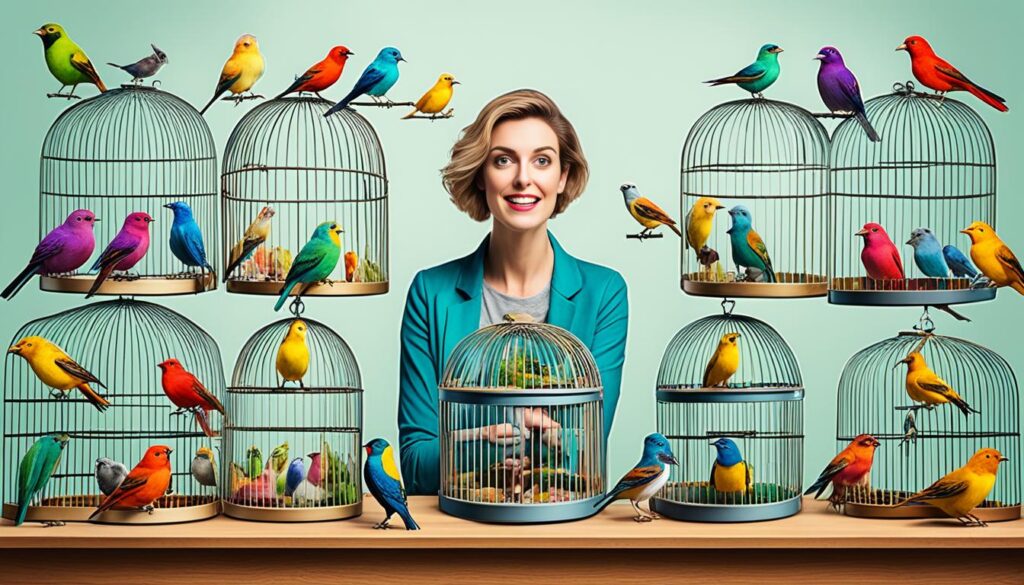
Conclusion
In conclusion, many bird types are famous for how well they sing and talk. African Greys, parakeets, and Amazon parrots are known for talking lots. But, each bird is different. When choosing a bird, it’s good to look into what each kind offers. Do you want a bird that talks a lot or one with fewer words? With the right love and support, birds can learn to talk in amazing ways. This can bring joy to their owners.
Talking birds show us how smart they are. They don’t just copy human words. They understand and use some words to mean things. African Grey parrots, parakeets, and Amazon parrots are stars in the bird-talking world. They teach us a lot about bird smarts and how they communicate.
The key message is to know what different birds need if you are thinking about getting one. Choosing well and taking good care helps us create deep bonds with these unique animals. Their talking is a special part of sharing your life with a bird.
FAQ
What are some of the most talkative bird species?
Some top talking birds are African Greys, Parakeets, and Amazon Parrots. There are also Ring-necked Parakeets, Quaker Parakeets, and more. Cockatoos and Myna Birds round out the list.
Why are African Grey parrots known for their talking abilities?
African Grey parrots stand out for their talking skills. They’re smart and can talk like little kids. Some famous African Greys can even solve problems and ask questions.
What makes parakeets (budgies) good talking birds?
Parakeets or budgies are popular for good reason. They can learn to talk and are easy to take care of. Even though they learn slowly, they catch on to new words easily.
What are the talking abilities of Amazon parrots?
Amazon parrots, like the Yellow-Naped Amazon, can talk clearly. They pick up songs too. Their voices are often described as being like a person’s.
What other bird species are considered to have excellent talking skills?
Ring-necked Parakeets, Quaker Parakeets, and Cockatoos also have strong talking skills. Macaws and Myna Birds are in the grouping too. They can mimic us and have a wide range of sounds they make.
What factors should I consider when adopting a talking bird?
When getting a talking bird, know what the bird needs. Learn about the species and the bird itself. This helps ensure they’re happy and talk a lot. Think about noise, what they eat, their cage size, and your time.

